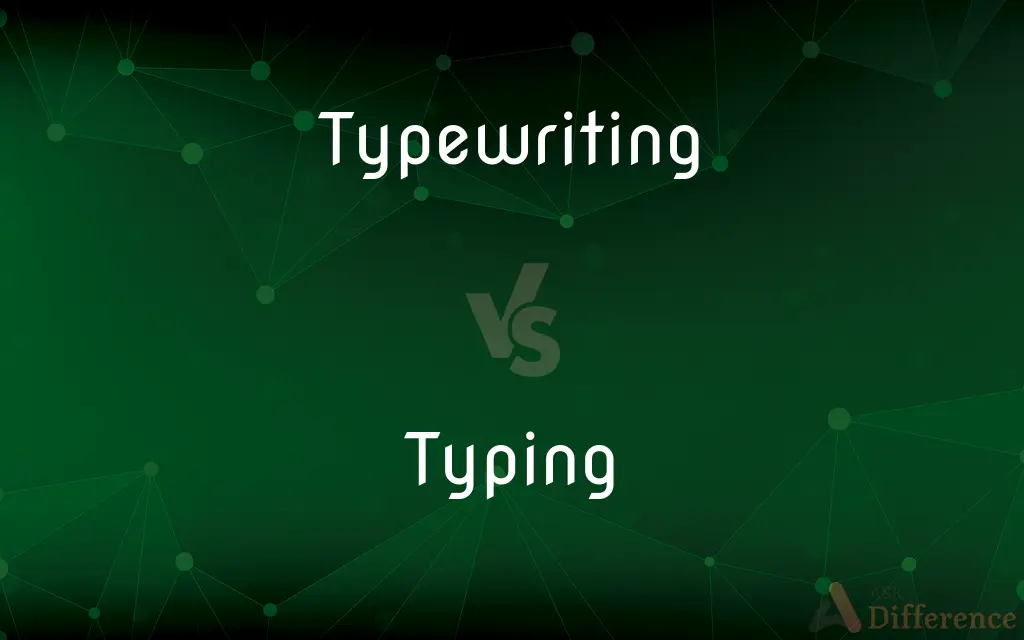Typewriting vs. Typing — What's the Difference?
By Maham Liaqat & Urooj Arif — Updated on March 24, 2024
Typewriting emphasizes mechanical or manual text input, typically on a typewriter, while typing encompasses all forms of text input, including digital keyboards.

Difference Between Typewriting and Typing
Table of Contents
ADVERTISEMENT
Key Differences
Typewriting refers to the act of producing characters on paper through a mechanical machine known as a typewriter, where each key press results in a corresponding character being imprinted on paper through an ink ribbon. This process is tactile, requiring physical effort and skill, and often produces a distinctive sound and feel. On the other hand, typing is a broader term that includes inputting text into any device, such as computers, tablets, or smartphones, using keyboards or touchscreens. Typing can be both tactile and virtual, with feedback ranging from physical key presses to haptic vibrations on touchscreens.
Typewriters are often associated with a certain nostalgia and the charm of a bygone era, valued for their simplicity and the direct connection between the typist and the physical document. They lack the modern features of digital text editing, such as spell check, copy-paste, and easy corrections. Typing on modern devices, however, offers immense flexibility and efficiency, with advanced editing tools and the ability to easily share and store documents digitally.
The learning curve for typewriting can be steeper than for typing on modern keyboards, as typewriters do not typically offer corrective features like backspace or spell check, demanding higher accuracy from the typist. Typing on digital devices is more forgiving, allowing users to easily correct errors and revise text, which can be particularly helpful for beginners or those developing their typing skills.
Typewriting has a unique aesthetic appeal, often celebrated in art, literature, and journalism for its authenticity and the tactile experience it offers. This has led to a resurgence of interest in typewriters among enthusiasts and collectors. Typing, in its digital form, while practical and ubiquitous, often lacks this tactile satisfaction and personal touch, emphasizing efficiency and convenience over the sensory experience.
While typewriting produces physical documents that are immediately tangible, typing in a digital environment involves creating digital files that can be easily edited, duplicated, and shared, highlighting a fundamental difference in the end product and its distribution. The tangible nature of typewritten documents can add a personal or authentic touch, whereas digital documents prioritize flexibility and accessibility.
ADVERTISEMENT
Comparison Chart
Medium
Mechanical typewriters
Digital devices (PCs, smartphones)
Feedback
Physical key press
Physical or virtual key press
Editing
Limited, often manual correction
Extensive digital editing tools
Skill Level
High accuracy required
More forgiving, suitable for all levels
Output
Physical paper document
Digital text file
Compare with Definitions
Typewriting
The act of using a typewriter to produce text on paper.
She enjoyed the tactile feedback of typewriting her novel.
Typing
Inputting text into a device using a keyboard or touchscreen.
Typing on her tablet was her preferred method for taking notes.
Typewriting
Involves mechanical keys and ink ribbons.
The typewriting process is distinguished by the striking sound of keys.
Typing
Easier to learn and correct mistakes.
He improved his typing speed through online games.
Typewriting
Demands accuracy and proficiency.
His expertise in typewriting was evident in the error-free manuscript.
Typing
Creates a digital text file, easily shared and edited.
Typing the document allowed for easy email distribution.
Typewriting
Often associated with nostalgia and authenticity.
The typewriting on the invitation added a vintage charm.
Typing
Can be done on various digital devices.
Typing has become faster with predictive text on smartphones.
Typewriting
Produces a tangible paper document.
The typewriting resulted in a pile of neatly stacked pages.
Typing
Offers advanced editing and formatting options.
Typing the report on a computer made it easy to revise.
Typewriting
The act, process, or skill of using a typewriter.
Typing
Typing is the process of writing or inputting text by pressing keys on a typewriter, computer keyboard, cell phone, or calculator. It can be distinguished from other means of text input, such as handwriting and speech recognition.
Typewriting
Copy produced on a typewriter; typescript.
Typing
A number of people or things having in common traits or characteristics that distinguish them as a group or class:That type of car was popular in the 1970s. See Synonyms at kind.
Typewriting
The act, or the skill, of using a typewriter.
Typing
A person or thing having the features of a group or class:He is the type of person that is bound to get into trouble.
Typewriting
The material produced by a typewriter; typescript.
Typing
An example or a model having the ideal features of a group or class; an embodiment:"He was the perfect type of a military dandy"(Joyce Cary).
Typewriting
Present participle of typewrite
Typing
A person regarded as exemplifying a particular profession, rank, or social group:a group of executive types; a restaurant frequented by tourist types.
Typewriting
The act or art of using a typewriter; also, a print made with a typewriter.
Typing
A figure, representation, or symbol of something to come, such as an event in the Old Testament that is believed to foreshadow another in the New Testament.
Typewriting
Writing done with a typewriter
Typing
(Biology)The type specimen, type species, or type genus, which serves as the basis for the name of a species, genus, or family.
Typing
A small block of metal or wood bearing a raised letter or character on the upper end that leaves a printed impression when inked and pressed on paper.
Typing
Such pieces considered as a group.
Typing
Printed or typewritten characters; print:Let's see how your letter looks in type.
Typing
A size or style of printed or typewritten characters; a typeface:a sans-serif type.
Typing
A pattern, a design, or an image impressed or stamped onto the face of a coin.
Typing
To write (something) using a typewriter.
Typing
To input (something) manually on an electronic device, especially by using a keyboard.
Typing
To assign to a category; classify or characterize:a political candidate who was typed as indecisive.
Typing
To typecast:an actor afraid of being typed as a gangster.
Typing
To write with a typewriter or computer keyboard.
Typing
Assigning or classification by type.
Typing
The act of typing on a keyboard.
Typing
Present participle of type
Typing
Writing done with a typewriter
Common Curiosities
Do people still use typewriters?
Yes, typewriters are still used by enthusiasts and for specific artistic or nostalgic purposes.
Can typewriting be considered a form of typing?
Yes, typewriting is a specific form of typing that uses a mechanical typewriter.
Is typing faster than typewriting?
Typically, yes. Modern typing on digital devices can be faster due to advanced keyboards and editing tools.
Can you correct mistakes easily while typewriting?
Corrections in typewriting are more cumbersome, often requiring manual correction tools like white-out.
Is typing more efficient than typewriting?
In general, typing on digital devices is more efficient due to editing features and text management tools.
Do typewriters require electricity?
Most typewriters are mechanical and do not require electricity, unlike electronic typewriters and digital devices.
Can typewritten documents be digitized?
Yes, typewritten documents can be scanned or photographed to create digital copies.
Are there any health implications of typing or typewriting?
Prolonged typing or typewriting without proper ergonomics can lead to strain or repetitive stress injuries.
How do error correction features compare between typing and typewriting?
Typing on digital devices offers extensive error correction features like backspace and spell check, unlike typewriting which has limited correction capabilities.
Can typing skills improve typewriting performance?
Yes, general typing skills can transfer to typewriting, though the latter may require adjustments for the mechanical nature of typewriters.
Are typewriters still manufactured?
New typewriters are rarely manufactured today, but refurbished and vintage models are widely available.
Which is more durable, typewritten or typed documents?
Typewritten documents on high-quality paper can be very durable, but digital documents have the advantage of easy duplication and backup.
How does the tactile feedback compare between typing and typewriting?
Typewriting often provides more tactile feedback due to the mechanical action of keys, while typing on modern keyboards can be less tactile, especially on membrane or touchscreen keyboards.
Is typewriting considered more environmentally friendly than typing?
Typewriting doesn't require electricity, which could be seen as more environmentally friendly, but it also uses consumables like ink ribbons and paper.
Can typewriting be a hobby?
Yes, many people enjoy typewriting as a hobby for its tactile feel, aesthetic, and connection to literary history.
Share Your Discovery

Previous Comparison
Remind vs. Recall
Next Comparison
Objective vs. AnalyticalAuthor Spotlight
Written by
Maham LiaqatCo-written by
Urooj ArifUrooj is a skilled content writer at Ask Difference, known for her exceptional ability to simplify complex topics into engaging and informative content. With a passion for research and a flair for clear, concise writing, she consistently delivers articles that resonate with our diverse audience.















































